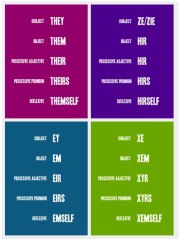Hey GFers!
With a month left until FYStaff training, we’d like to congratulate you all again on your acceptance to FYSOP, especially those of you who are joining the Gender Focus Issue Area! We cannot wait to finally meet you all in person in August!
In Gender Focus, we use a lot of terminology that may be unfamiliar to some. We always encourage respectful questions if there is ever a point where you are unsure as to what people are referring. In this post, we highlight a few important terms (though this is by no means the master post of terms) that we think would be helpful in our discussions as well as everyday navigating of the GF website!
Ally: Someone who confronts heterosexism, homophobia, biphobia, transphobia, heterosexual and genderstraight privilege in themselves and others; a concern for the well being of lesbian, gay, bisexual, trans*, and intersex people; and a belief that heterosexism, homophobia, biphobia and transphobia are social justice issues.
Androgynous: A person who may appear as and exhibit traits traditionally associated as both male and female, or as neither male nor female, or as in between male and female.
Cisgender: 1) A person whose gender identity is aligned to what they were designated at birth on the basis of their physical sex. 2) a non-trans* person.
Down Low (D/L): A term primarily used in homosexual/queer male communities of color, particularly those of Africana descent, denoting a lack of disclosure of homosexual desire, behavior, or identity.
Femme: 1) A person who expresses and/or identifies with femininity 2) A community label for people who identify with femininity specifically through a queer and/or politically radical and/or subversive context. 3) A feminine identified person of any gender/sex.
Genderqueer: 1) An umbrella term for people whose gender identity is outside of, not included within, or beyond the binary of female and male. 2) Gender non-conformity through expression, behavior, social roles, and/or identity. 3) People who identify as both transgender and queer who see gender identity and sexual orientation as overlapping and interconnected.
Heteronormativity: A binary gender system in which only two sexes are accepted. Followers of this concept maintain that one’s gender identity and one’s gender role ought to be congruent with one’s external genitalia, and that one ought to display a heterosexual sexual preference.
Heterosexism: Prejudice against individuals and groups who display non-heterosexual behaviors or identities, combined with the majority power to impose such a prejudice.
Intersex: One who is born with sex chromosomes, external genitalia and/or an internal reproductive system that is not considered “standard” or normative for either the male or female sex. Preferred term to hermaphrodite.
Pangender: A person whose gender identity is comprised of many gender identities and/or expressions.
Pansexual: 1) A sexual orientation where a person desires sexual partners based on personalized attraction to specific physical traits, bodies, identities, and/or personality features which may or may not be aligned to the gender and sex binary. 2) A sexual orientation signifying a person who has potential emotional, physical, and/or sexual attraction to any sex, gender identity or gender expression. 3) Sexual orientation associated with desiring/loving a person’s personality primarily, and specific bodily features secondarily.
Queer: 1) An umbrella term representative of the vast matrix of identities that are outside of the gender normative and heterosexual or monogamous majority. Reclaimed after a history of pejorative use, starting in the 1980s. 2) An umbrella term denoting a lack of normalcy in terms of one’s sexuality, gender, or political ideologies in direct relation to sex, sexuality, and gender.
Transgender (TG): 1. An umbrella term describing a diverse community of people whose gender identity differs from that which they were designated at birth on the basis of physical sex characteristics. 2. Expressions and identities that challenge the binary male/female gender system in a given culture. 3. Anyone who transcends the conventional definitions of ‘man’ and ‘woman’ and whose self-identification or expression challenges traditional notions of “male” and “female.”
Transphobia: 1. The fear, hatred, or intolerance of people who identify or are perceived as transgender. 2. Fear and hatred of all those individuals who transgress, violate or blur the dominant gender categories in a given society.
Two-Spirit(ed): 1) Native American term to describe person who embodies attributes of both masculine and feminine genders, have distinct gender and social roles in their tribes, and are often involved with rituals. Their dress is usually mixture of male and female articles and they are seen as a separate or third gender. The term two-spirit is usually considered to specific to the Zuni tribe. Similar identity labels vary by tribe such as Wintke (Lakota), Hee-man-eh (Cheyenne), and Nedleeh (Navajo) 2) Native Americans who are queer or transgender.
GFLuv,
Tré&Emma

Leave a comment